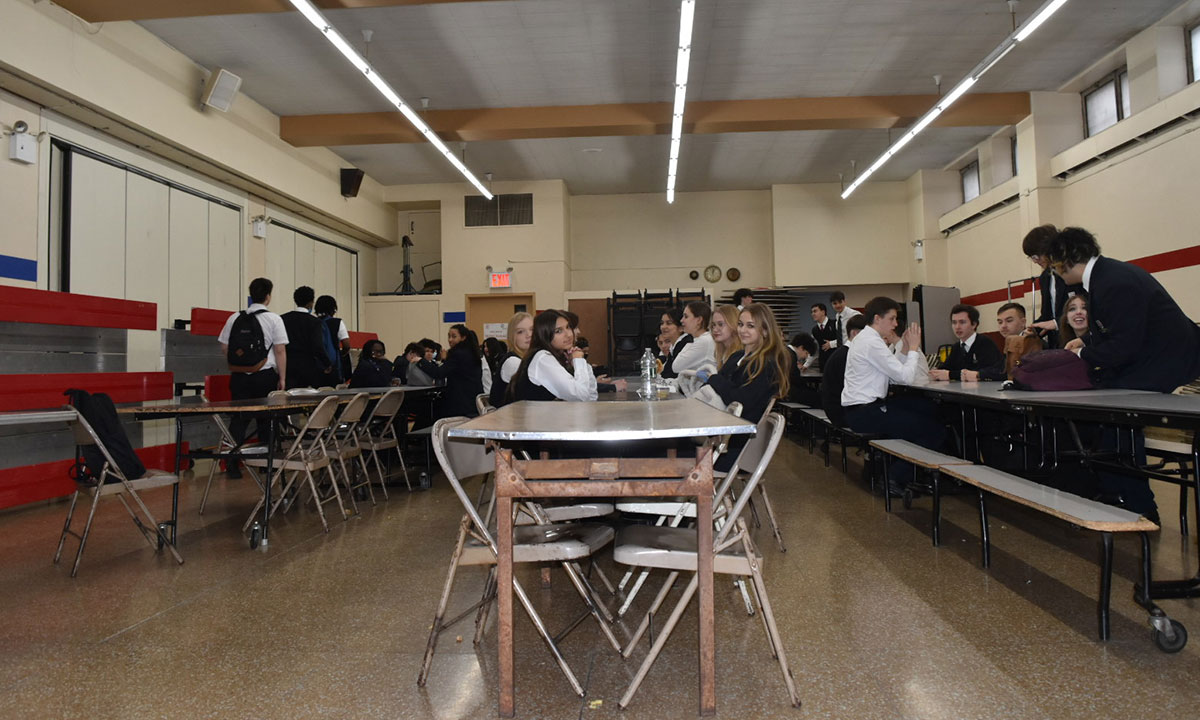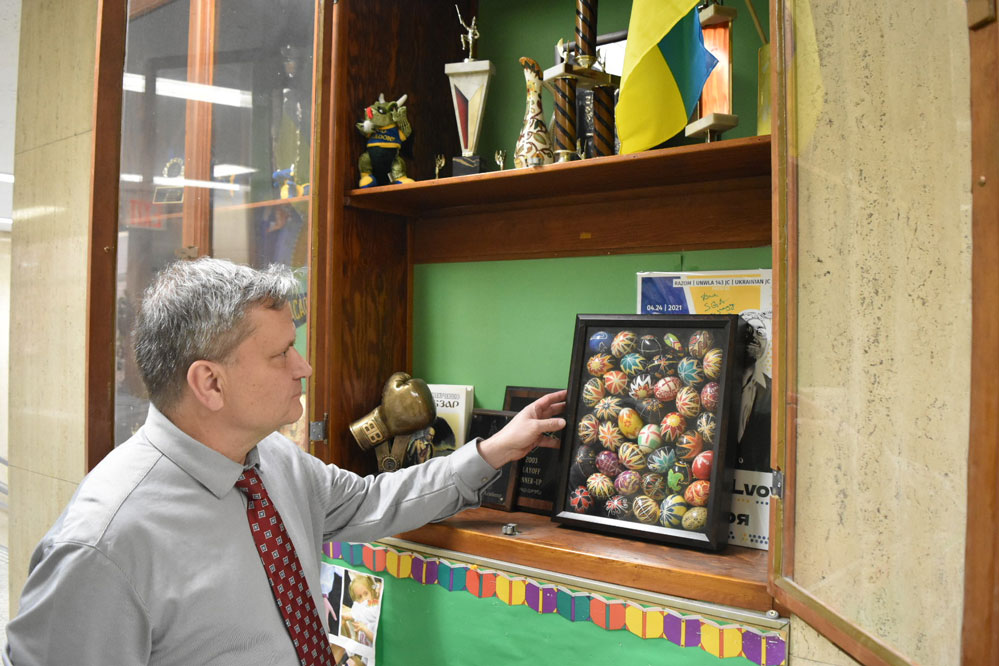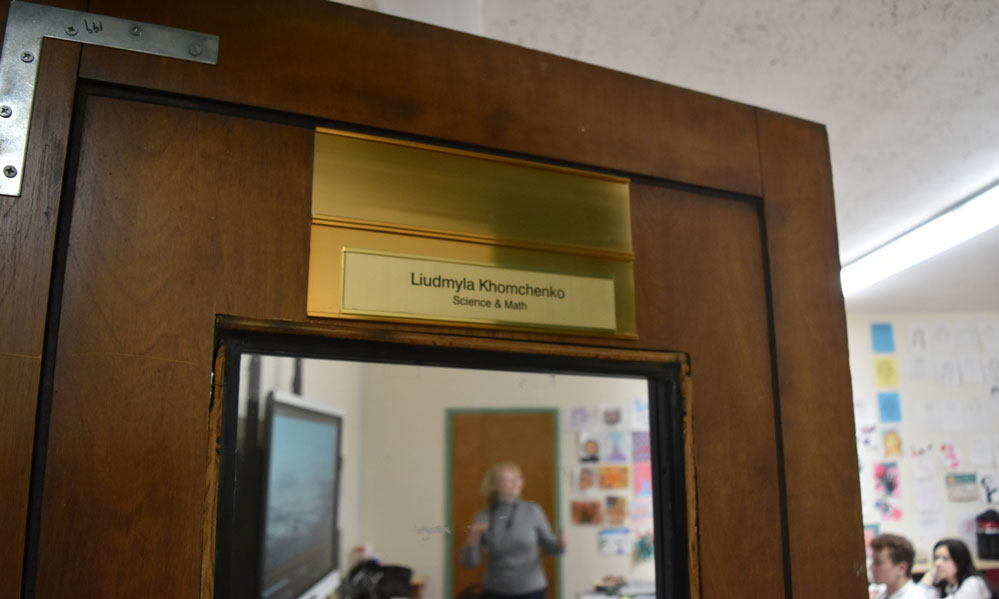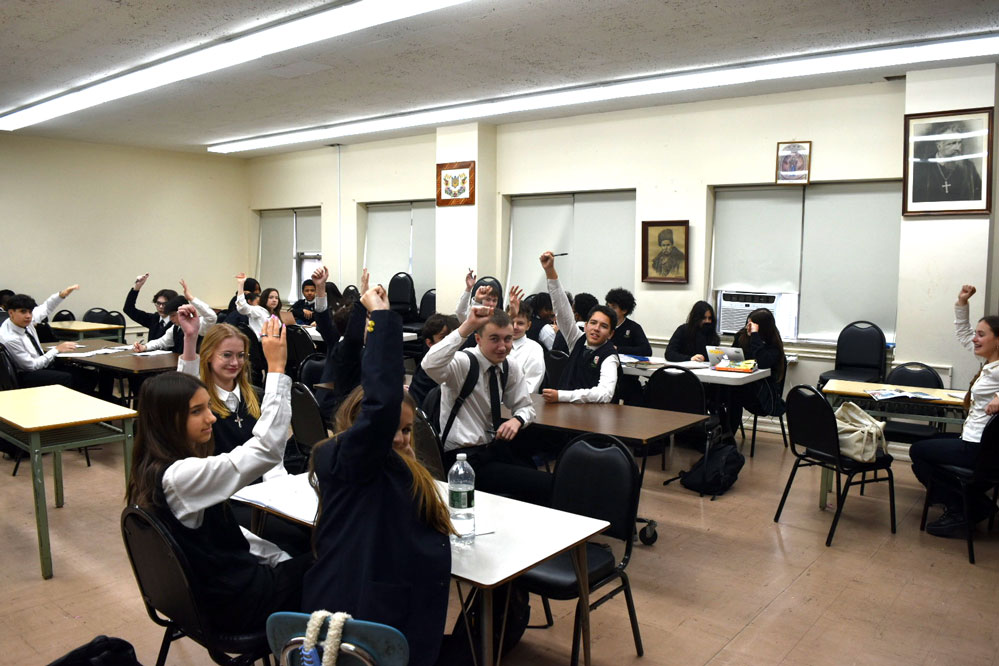A Year into the War, A Small NYC School Has Become A Haven for Ukrainian Teens
St. George Academy in Manhattan’s Little Ukraine sees its enrollment grow — along with lockers and textbooks

Get stories like this delivered straight to your inbox. Sign up for The 74 Newsletter
As Russia’s invasion of Ukraine forced them to flee their homeland more than a year ago, enrollment at a tiny New York City school grew with teen refugees seeking a place that felt like home.
The new students at St. George Academy in Manhattan’s Little Ukraine neighborhood say they are relieved to be attending classes where they can speak their native language and relate to peers — but adjusting to life in New York City has not been easy.
“I saw the looks on these kids’ faces as we did tours of the school,” said St. George Academy principal Andrew Stasiw. “And we would walk by classrooms and they see people who sound like them and speak Ukrainian … there was a sense of comfort and relief.”
But there’s a new and different life off of St. George’s campus that lacks the schools’ reminders of home.
Gone is the pageantry of hearing people in the U.S. sing their national anthem and parade in solidarity as their country was bombed by Russia. Now they are navigating life in a city that feels unfamiliar.
As St. George Academy bought new lockers and textbooks for the Ukrainian students — many of whom are attending on full scholarships — the refugees have returned home to living situations that aren’t ideal: Some are without their parents who had to stay back and fight; others are living in shelters or in small, maxed out apartments.
And Stasiw has new worries — money. Now that enrollment has grown from 80 students to 140 — currently including 33 refugee students — he’s unsure how he can support them.
“When the war first broke out, our efforts here were to raise money for Ukraine,” Stasiw said. “Now we need to raise money for our Ukrainian students that are here.”
Welcoming dozens of new students put pressure on the small staff and building — so Stasiw got to work reshaping its landscape.
“I had to hire additional teachers. I had to get additional lockers. I had to buy a lot more textbooks,” Stasiw said.
Meanwhile, the newcomers’ lives in New York City are far from what they expected.
They know New York City from the movies, Stasiw said, “where it’s so beautiful and they just see Central Park, [the students] comment on how amazed they are by all the rats and violence … They suddenly don’t feel like they’re safe.”
One student currently lives in a homeless shelter with her mother, who often doesn’t have money for food and frequents the school’s small cafeteria for lunch.
Another student has been falling asleep in class most days. She’s sharing a small room with several people and an infant who keeps her up at night.
The new lockers St. George Academy scraped limited funds to buy are full of students’ belongings and several days worth of clothes because there is no storage space in their current dwellings.

Even though resources are stretched, Stasiw said he can’t turn away the Ukrainian students who have seen things that would be unimaginable to their peers.
One student, Stasiw said, “saw her city destroyed by missiles. She’s in shock.”
That student is now living in a homeless shelter that initially enrolled her in a public school. “She goes there … and she doesn’t speak any English … and she gets bullied by three girls,” Stasiw said.
Her mother came pleading to Stasiw to let her into St. George Academy, a high school, even though she’s only in eighth grade.
“We were able to offer her a uniform but she couldn’t afford shoes. So I gave her $100 right before Christmas,” Stasiw explained. But when she came back from their winter break, she returned the money to him. “She says, ‘some people we met gave us a free pair. They fit fine. Here’s the $100 back.’ ”
One Ukrainian parent asked if their daughter could live in the principal’s one bedroom apartment, because Stasiw lives nearby the school.
“They’re struggling,” Stasiw said about his new students, “but they’re not looking for a free ride.”
Even with the school expanding and changing, Stasiw remains focused on the challenging college-prep curriculum. Their 12th-grade classes have always been the smallest, he said, because “not everyone makes it to the finish line.”
“We’re not an easy school … We offer a lot of electives that they have to take. They’re going to take four years of computer coding. They’re going to take four years of music, they’re going to take astronomy, philosophy, psychology, sociology … Freshmen take two languages their first year … We’re still driving the curriculum.”
Behind the doors of the Academy are reminders of home … Not only is Ukrainian widely spoken but yellow and blue flags adorn most classrooms. For lunch, Stasiw will often treat his students to meals catered by neighborhood Ukrainian delis.

But once the school day is over, the students are back out in the city they find so unfamiliar — and much different from the quiet countryside many came from in Ukraine.
“I feel like New York is just scarier. There’s a lot of stuff going on in New York every day,” said ninth-grader Olha Stanko, whose mother doesn’t let her hang out with friends as late as she once did in Ukraine.
“It’s not as wonderful as I thought it was going to be, I thought it was going to be all high beautiful buildings and lots of parks,” said ninth-grader Nazariy Lanyk.
In addition to the culture shock, Stanko said she spends more time than the average teenager worrying about her father who can’t leave Ukraine because he’s under 65.
“I have my dad in Ukraine, which is pretty hard for me because I haven’t seen him in a really long time,” she said. “That’s the thing that’s hardest for me the most. Ukraine’s my home and I want to go back there. That’s one thing a normal teenager doesn’t have to go through.”

Stanko was able to find comfort in reuniting with her best friend — Nicole Kozmey, who is now a 10th-grader at St. George Academy — a world away from the war in their home country.
They’re not sure where they’ll be in the next few years — if they’ll graduate from St. George Academy or return home to Ukraine. But for now St. George Academy is hoping to keep being the place where they can focus on their education in the comfort of a Ukrainian community.
“Research will tell you that if students are afraid, not comfortable, they won’t learn,” Stasiw said. “So … that sense of warmth that they get from our teachers and from everybody in our small environment … I think that’s made all the difference in the world.”
Get stories like these delivered straight to your inbox. Sign up for The 74 Newsletter

;)
